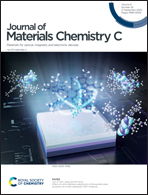Polyurethane-coated luminescent dye@MOF composites for highly-stable white LEDs†
Abstract
Encapsulating luminescent dyes in metal–organic frameworks (MOFs) for white-light illumination and displays has received tremendous attention in recent years due to the unique colour-tuning flexibility and designability. However, the luminescent dyes may suffer from degradation due to moisture and oxygen under operating conditions. The stability and reliability of dye-encapsulated MOF phosphors remain challenges to be addressed. Herein, a broadband-emitting MOF phosphor is prepared via an ambient self-assembly process with pyrromethene 546 (pm546), pyrromethene 605 (pm605) and sulforhodamine 101 (SRh101) simultaneously confined in porous nanoscale zeolitic imidazolate framework-8 (ZIF-8). The photostability and thermostability of the pristine phosphor are evaluated in detail. By further coating it with thermoplastic polyurethane (TPU), the relative fluorescence intensity of the pristine phosphor is remarkably enhanced by 52.54%. A highly-stable remote-type incandescent white-lighting device is fabricated with a 460 nm blue LED chip with CIE chromaticity coordinates of (0.465, 0.413), a correlated colour temperature (CCT) of 2642 K and a colour rendering index (CRI) of up to 85.



 Please wait while we load your content...
Please wait while we load your content...